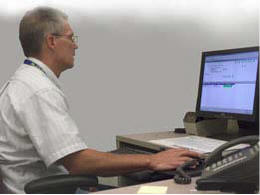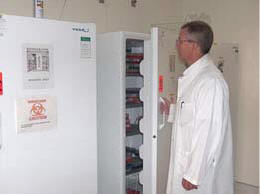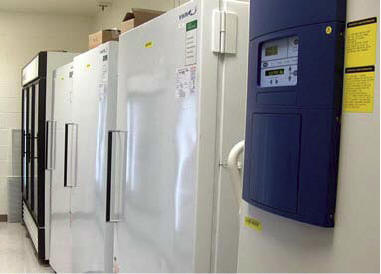
October/November 2005
Janet Ferguson
Preserving Evidence
An environmental monitoring system installed in the New
Jersey State Police Forensic Science Technology Center tracks the controls
needed to maintain forensic samples in the DNA Unit.
When Assistant DNA Laboratory Director, Edward LaRue,
reports to work at the new state-of-the-art DNA Laboratory at the New Jersey
State Police Technology Center, he now has the convenience of being able to
check the prior nights DNA run data at his own computer, from his own desk. The
lab’s other Assistant DNA Laboratory Director, Joe Petersack, and five lab
supervisors are provided the same level of efficiency, enabling each to
separately bring up their environmental monitoring system and check graphs and
charts that indicate trends in room and instrument temperature in their various
lab environments. Each individual lab supervisor can now troubleshoot and do
preventive maintenance based on record keeping information stored
electronically 24/7. They have never lost evidence or had evidence degraded.
How have they accomplished this?
Who? What?
Where? When? Why?
The New Jersey State Police Office of Forensic Sciences is located in the New Jersey State Police (NJSP) Technology Complex in Hamilton, NJ. It is a 200,000 sq. ft., state owned, full service building of which 50% is lab space with 10,000 sq. ft. allocated for the DNA Unit alone. It is run under the jurisdiction of the Department of Law and Public Safety/Office of the Attorney General and services every state and municipal police agency in NJ. The NJSP maintains a CODIS (combined DNA Indexing System) database of convicted felons and uploads profiles to the FBI’s national DNA indexing system (NDIS). The NJSP Office of Forensic Sciences moved in to validate in January 2004 and started actual casework in March 2004.

Prior to the building of the present
space, the laboratory was located in Ewing, N.J., having been leased in 1997.
The building wasn’t designed to be a forensic lab and they had to retrofit the
old building to accommodate their needs. This facility was quickly outgrown.
When the decision was made to build the new facility, LaRue and the existing
staff of six supervisors were fortunate to be called upon to assist in the
design of the new lab, working with the architects in regard to structural
considerations.
Fully ASCLD/LAB (American Society of Crime Laboratory Directors Laboratory Accreditation Board) and NFSTC (National Forensic Science Technology Center) accredited, the new lab meets the highest specifications for all federal guidelines. According to Ed LaRue, Assistant DNA Lab Director, “We designed our lab with ASCLD/LAB in mind. Compliance with DAB Standards is of the utmost importance.” The DNA Advisory Board (DAB) was created as part of the 1994 Congressional DNA Act. ASCLD/LAB audits against this document and ASCLD/LAB accreditation can only be obtained by a lab if all criteria are met. (The DAB advises the director of the FBI.) “We’re often called upon to testify in court and the first question we’re asked when we take the stand is ‘Are you ASCLD/LAB accredited?’”
The DNA Unit provides full time forensic lab services in the inspection and analysis of crime-related evidence. The unit validates casework, analyzes and creates DNA profiles, and stores forensic samples. According to Ed LaRue, the samples stored and monitored at the facility are, “Blood, saliva, semen, articles of clothing, bedding, weapons…anything discoverable.” Sample storage is an important issue. LaRue stated that, “The CODIS samples are stored forever if the individual is convicted of a felony.”
Monitoring
the DNA Amplification Room
Once the new building was completed, the environmental monitoring system was installed. “We knew we wanted to work with the same company that provided us with our existing environmental monitoring system. We consulted with the company and ultimately upgraded to a Centron system with 60 probes and ten licenses. Along with our current system in the new lab, we installed two wall mounts with touch screens – one in the DNA office and the second in our DNA Amplification room,” LaRue said.
The ability to track and record proved valuable in controlling the temperature of the Amplification Room. The instruments in the room are sensitive to temperature changes and the temperature can only vary by ± 2°. Humidity and ambient room temperature sensors along with a wall-mounted workstation were installed. With the environmental monitoring system in place, the lab directors were able to identify fluctuations in the room temperature. The room itself needed to be maintained in the 68-72° range. Data collected from the monitoring system tracked the temperature changes and provided information that led to an assessment of the heating and cooling system.
Hands Off
There were a number of manual activities that had to be performed in the labs on a regular basis. While room temperature was an important measurement to record, freezer temperature was another vital area that had to be to checked. Each day, a lab technician observed and recorded the temperature of each of the refrigerators and freezers. A single freezer holds up to $70,000 worth of reagents used for analysis. If the freezer malfunctioned, the reagents would be useless and would have to be discarded. The new monitoring system not only eliminated the need to manually check each refrigerator and freezer but allowed for continuous monitoring. The once-a-day technician check assured that the freezer or refrigerator was functioning properly at that time. There was potentially 23 plus hours for a malfunction to occur and go unnoticed. The monitoring system assisted in keeping evidence preserved on a 24-hour basis. A problem, such as a freezer door being left ajar or open for a certain amount of time, would be recorded. Personnel would be alerted that a malfunction had occurred and proper remediation could take place.
Another necessary manual procedure was annual calibration of the thermometers. An NIST traceable thermometer had to be purchased and ice bath and hot water bath calibration tests had to be conducted. The issue of inaccurate measurement was much the same as daily temperature check on the refrigerators and freezers. If a thermometer was found to be inaccurate, the question became how long had the measurements been off and what systems might have been affected by the inaccurate readings? The monitoring system eliminated the need to perform calibrations while providing the ability to see historic data on temperature as needed.

Figure 2: Alerts for doors left open
for a period of time
prevent loss of expensive reagents

Figure 3: The monitoring system not only eliminated the need to manually check the temperature for each refrigerator and freezer but allowed for continuous temperature monitoring.
A Desktop
View
While being interviewed for this article, one assistant lab director looked at his computer screen and checked the current temperature in the Amplification Room (68.6°). For the lab directors at the NJSP, the monitoring system put information literally at their fingertips. The installation of the monitoring system automated many systems that had been done manually and put the ability to observe room conditions and lab equipment at their desktop.
When the assistant lab director reports to work, he can bring up the system and look at trends and graphs. One advantage this offers is in the area of preventative maintenance. If the temperature in the room is fluctuating, the director may decide to wait for maintenance to stabilize the temperature before doing a DNA run. If a DNA run doesn’t look right, there are charts that can be accessed from the computer. Larger machines run 96 samples every three hours and will run overnight. A look at the system can determine what took place during the night and if there were any items that need to be addressed. If a problem is indicated, then adjustments can take place and instrument problems can be checked. Call lists for each unit can be made.
Currently, the new system stores data on the main computer, which is backed up to a web server. Recordkeeping is done electronically and is one less item that has to be stored in the lab.
Quality
Assurance
Requirements for storage, monitoring, and data collection of DNA evidence has increased in the last decade. The media attention and public awareness of the role of crime labs has increased dramatically. Though ASCLD/LAB accreditation is voluntary, many defense attorneys will challenge evidence if a lab is not accredited. ASCLD/LAB accreditation demonstrates that a crime laboratory’s procedures meet established standards. A quality assurance program is a vital part of achieving and maintaining accreditation. Since the installation of the monitoring system, no evidence has been lost or degraded. The Amplification Room is a critical area and the installation of an environmental monitoring system is a tool to achieve quality assurance and operations in evidence processing and storage.